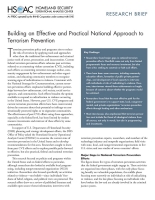by Brian A. Jackson
 Researchers found major gaps in national terrorism prevention efforts: Shortfalls came not only from limited programmatic focus and resource investment, but also from critics seeking to constrain or halt such efforts. There have been some successes, including community education efforts, formation of public-private partnerships, and development of local capacity to intervene with individuals at risk of radicalizing to violence. However, interviewees viewed those achievements as fragile because of concerns about whether the programs would be sustained. Researchers found that the most effective path for the federal government is to support state, local, nongovernmental, and private organizations' terrorism prevention efforts through funding and other mechanisms. Most interviewees also emphasized that terrorism prevention must include the threat of ideological violence from all sources, not only in words, but also in programming and investments.
Researchers found major gaps in national terrorism prevention efforts: Shortfalls came not only from limited programmatic focus and resource investment, but also from critics seeking to constrain or halt such efforts. There have been some successes, including community education efforts, formation of public-private partnerships, and development of local capacity to intervene with individuals at risk of radicalizing to violence. However, interviewees viewed those achievements as fragile because of concerns about whether the programs would be sustained. Researchers found that the most effective path for the federal government is to support state, local, nongovernmental, and private organizations' terrorism prevention efforts through funding and other mechanisms. Most interviewees also emphasized that terrorism prevention must include the threat of ideological violence from all sources, not only in words, but also in programming and investments.
Terrorism prevention policy and programs aim to reduce the risk of terrorism by applying tools and approaches other than the traditional law enforcement and criminal justice tools of arrest, prosecution, and incarceration. Current federal terrorism prevention efforts subsume past activities, referred to as countering violent extremism (CVE), including such efforts as countering extremist messages online, community engagement by law enforcement and other organizations, and educating community members to recognize warning signs of radicalization to violence. Consistent with the National Strategy for Counterterrorism, current terrorism prevention efforts emphasize building effective partnerships between law enforcement, civil society, social service agencies, and communities. Such efforts broaden the options available to respond to radicalization to violence occurring in the United States. However, past U.S. CVE programs and current terrorism prevention efforts have been controversial, driven by concerns about their potential to infringe on constitutionally protected rights or to stigmatize communities. The effectiveness of past CVE efforts using these approaches, especially at the federal level, has been limited by modest resource investments and mistrust of these efforts by some communities.
In support of U.S. Department of Homeland Security (DHS) planning and strategy development efforts, the DHS Office of Policy asked the Homeland Security Operational Analysis Center (HSOAC) to examine the current state of terrorism prevention in the United States and to develop recommendations for this area. Researchers sought to learn from past CVE efforts and to explore possible paths forward to effective, but also practical, federal and national terrorism prevention.
This research focused on policies and programs within the United States and on federal efforts in particular, although researchers also looked at available local programming, including nongovernmental organization (NGO) initiatives. Researchers also focused specifically on activities related to violence — not beliefs — since individuals' freedoms of belief, religion, and political view are protected. The research effort drew on a review of published literature and available open-source threat information; interviews with terrorism prevention experts, researchers, and members of the technology industry and nonprofit organizations; field visits with state, local, and nongovernmental organizations in five U.S. cities; and case studies of seven countries' efforts.
No comments:
Post a Comment